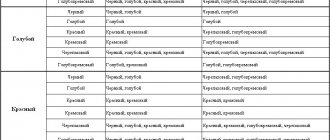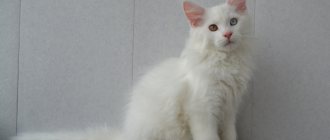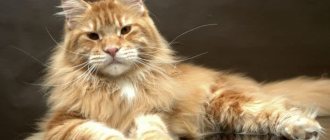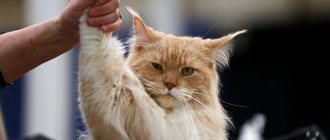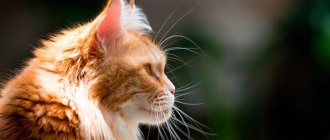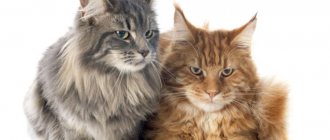Classification of suits
To simplify the characteristics of Maine Coons, felinologists use a special EMS coding. There are two main genetic colors of the breed - black and red (red). When characterizing the color of an individual cat, take into account:
- coat color;
- type of pattern;
- the presence of white inclusions and spots.
The main hair colors are distinguished:
- black;
- red;
- cream;
- blue;
- white;
- tortoiseshell;
- silver;
- smoky.
There are “coons” of an interesting golden color. But today it is not recognized in the felinological community.
Pigmentless (white) spots come in the following variations:
- “Van” is an almost white cat with small spots of a different color.
- “Harlequin” - white color acts as a background for large spots of a different shade.
- “Bicolor” - two colors are equally represented in the color of the animal.
- Individual white spots on the legs and chest.
The pattern on a cat's fur is tabby. It can have the following variations:
- Chinchilla: colored part – 1/8 of a hair.
- Shaded: colored part – ¼ hair.
- Marble (classic pattern for cats).
- Tiger coloring.
- Spotted variation.
- Ticked drawing.
- Agouti is a pattern that has not yet been fully formed.
Representatives of this breed have any eye shade that matches their color:
- blue (only for white “coons”);
- yellow of varying saturation;
- green;
- heterochromia (multi-colored eyes - for example, yellow and blue).
There are several main types of colors: tabby (presence of a pattern), solid (solid, solid, without patterns on the coat), smoky, tortoiseshell, silver.
Dangerous shining beauty
Responsible breeders are wary of breeding two white Maine cats, and with good reason. Radiant beauty is fraught with danger. Nature has decreed that the gene responsible for the appearance of an unusual color can simultaneously lead to deafness. Hearing is most often absent in blue-eyed cats. If the coon's eyes are different colors, then the deafness may be one-sided, on the side of the blue eye.
A common companion of white Maine cats is allergies. It makes the eyes water, the fur turns yellow, and the animal becomes more passive. At the first sign of an allergy, you should contact your veterinarian and be more careful when choosing food.
Choosing food for any snow white is a difficult task. In order not to lose the beautiful color, it is necessary to exclude products containing natural and synthetic dyes from your pet’s diet. Vegetables (beets, carrots, various algae), offal (liver, heart, kidneys), and various types of special cat food can reduce the whiteness of the color.
The photo shows the cat Columbus from the Gray Claw`s cattery
The photo shows the cat Columbus from the Gray Claw`s cattery
Tabby
Main characteristics of the patterns on Maine Coon fur:
- Stripes on the forehead that form the letter "M".
- Dark stripes on the cheeks.
- “Necklace” of stripes on the chest.
- Dark lining of eyes, lips, nose.
- Horizontal encircling stripes on the paws.
- Small spots on the abdomen.
There are four main types of patterns:
- Classic, “marble”. There are round patterns on the sides, and solid lines along the back.
- Spotted. Two design options - dotted stripes or small spots.
- Brindle. There are vertical spots on the sides of the cat, and a dark stripe running down the back.
- Ticked. The pattern is noticeable only on the “face”. The tip of each hair is dark.
The most interesting tabby color is “forest”, black “merle”. A cat of this color resembles a wild animal.
Marble “coons”:
Solid
The main feature of the solid color is the uniform distribution of shade throughout the body. The color of the fur is bright, rich: the hair is evenly colored from tip to spine. Disadvantages according to the standard:
- residual patterns on the body or head;
- the presence of an undercoat that is lighter than the awn;
- marks of a different shade.
The main solids of Maine Coons are:
- black;
- cream;
- red;
- white;
- blue.
The breed standard does not recognize the following color variations:
- lilac;
- gold;
- "faun";
- chocolate;
- color point;
- "cinnamon".
An interesting color in the category is black. Grooming and preparation for an exhibition are complicated: the cat needs to be combed frequently to remove dead hairs that turn brown. New hairs are less saturated - they stand out with a grayish tint. Over time they darken, turning into rich black.
Maine Coon black:
Interesting is the blue solidus, which is more common in Europe than in the CIS. The shade of this cat's fur is grayish, smoky with a beautiful bluish tint.
Blue Maine Coon:
Red Maine Coons are no less amazing. They rarely come in a pure solid color: a tabby pattern appears - tiger stripes, inclusions.
Red "kun":
A lighter version of red solid is cream. This cat's coat is a soft shade of cappuccino and ginger. Pure solid color is not observed here either - there are spots and tiger stripes on the fur coat.
Cream Maine Coon:
White Maine Coons are very interesting - it is not a separate color, but its absence. The animal's hairs are not colored with colored pigments. White babies may be born with small patches of color on their “face” - they go away during the molting process.
Snow-white cats are blue-eyed. They are also characterized by heterochromia - multi-colored eyes. However, such animals are often born deaf. Therefore, conscientious breeders never breed two white “coons.”
White color "coon":
Features of care and maintenance
Keeping snow-white pets is not much different from caring for other representatives of the breed and consists of carrying out hygienic procedures, organizing space for play and relaxation, selecting the right diet and regulating food intake.
A feature of keeping white coons is more thorough coat care, which involves:
- weekly combing using a fine-tooth comb;
- bathing using special shampoos or gels every 2–3 weeks or as needed;
- trimming claws if the animal is not accustomed to a scratching post;
- ear cleaning.
The condition and shade of the coat largely depends on the animal’s well-being and nutrition. White coons are prone to allergic reactions. Cats' eyes begin to water, leaving unsightly marks on their faces, and their fur takes on a yellowish tint. If these and similar signs appear, consult a veterinarian.
When animals eat food containing natural and synthetic dyes, for example, carrots, beets, liver, the fur of white coons may acquire a certain shade. Therefore, these products are given to snow-white coons carefully and no more than once a week.
Smoky, silver
Smoky “coons” stand out from other representatives of the breed due to the color of their hair: its root part is perfectly snow-white. This distinguishes “smoke” from the blue, lightened color.
Smoky options: black, blue, tortoiseshell. The suit has three types:
- regular – the hair is ½ dyed.
- shaded – the hair is ¼ white.
- chinchilla – the colored part is 1/8 of the hair.
Smoky color of Maine Coon:
If the smoky (with a snow-white “root”) coat has patterns, the color is called silver. The kitten is born light-colored; with age, the fur darkens and stripes appear on it. Breeders distinguish the future silver color from white by the shade of the iris. White animals have blue eyes, silver ones have greenish eyes.
Silver "kun":
How to feed cats correctly
Maines can be fed natural food and prepared food. A peculiarity of the organization of their nutrition is the non-alternative preference for one of the methods.
Mixed feeding is unacceptable.
When choosing natural food, your snow-white pet’s diet includes:
- raw beef and boiled boneless chicken;
- boiled beef or chicken offal based on the preferences of the animal with limited (up to 1 time per week) liver consumption;
- raw or boiled chicken yolk 1 or 2 times a week;
- dairy products (cottage cheese, kefir, yogurt) are introduced from 4 to 5 months, with the exception of milk - it is given only to kittens up to 3 months, and the adult body of coons does not absorb this product;
- raw or boiled vegetables, with the exception of potatoes and legumes;
- cereals.
The frequency of food intake depends on the age of the animal:
- kittens up to 3 months are fed 5 times a day;
- by 6 months, the frequency of feedings is reduced to 3 times;
- at 8 they switch to an adult diet - 2 times, morning and evening.
Choosing ready-made food will significantly save the animal owner’s time. In the case of Maine Coons, they can be used from 8 to 10 months, giving preference to professional specialized dry food and premium canned food. They are not cheap, but they are guaranteed to contain all the substances necessary for the functioning of the animal’s body.
And one more nuance: the bowl for cats of this breed must be large and stable.
"Turtle"
The black tortoiseshell color of Maine Coons comes in two varieties:
- Thorby. A combination of red and black (or dark brown) shades.
- Torty. Adding a dark cream shade to the red. If such a color is lightened, it is considered blue-cream.
Varieties of “turtles” are silver and smoky.
Interestingly, tortoiseshell “coons” are basically cats. Cats of this color can be born with a probability of 1:1000.
White markings of various locations and sizes are sometimes noticeable on tortoiseshell animals. If they have clear boundaries, they are considered “calico” - “shred”, “chintz”. The suit is also characterized by red spots.
Tortoiseshell color:
White spot
The main color of the “kuna” can be complemented by various white inclusions:
- "Van." The cat is completely white. But individual spots are allowed on the head, tail, and body.
- "Harlequin". Large spotting on a snow-white background.
- "Bicolor". The combination of white and color is approximately 50/50.
- "The tuxedo". Placement of the "white shirt" on the chest and front legs.
- "Medallion". White spot on chest.
- "Mitts." White “socks” on the paws.
- "Buttons." Small white marks, spots all over the body.
Harlequin color:
Bicolor color:
Color table (calculator)
Maine Coons are surprising in that they are not distinguished by their rare colors. Each is unique in its combination of shades, the presence of tabby, and white inclusions. Another interesting point is that the same “clothes” look different on different “coons”. It is acceptable to say that every Maine Coon has a rare color.
To determine what color the offspring will be, breeders refer to the table of colors of the “forest” breed.
The rarest and most expensive Maine Coon colors
Maine Coon breeders are of the opinion that these felines are beautiful regardless of coat color. Fashion is a capricious lady. From time to time, the demand for kittens of a certain color changes. In any case, the rarest shades include the following:
- brown with spots reminiscent of autumn foliage;
- creamy blue, very close to tortoiseshell with pastel tones;
- red with black spots and white patches. This variety is often called chintz;
- white wool with cream spots, called diluted calico. Even less common is this type of blue color with a solid pattern;
- spotted kittens with spots. This is generally a rare and atypical combination for this breed.
